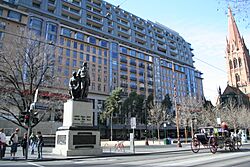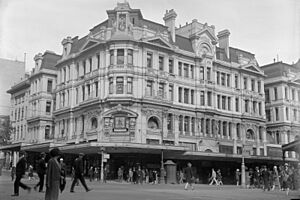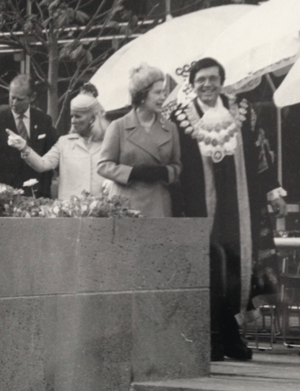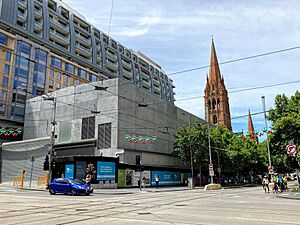City Square, Melbourne facts for kids
Quick facts for kids City Square |
|
|---|---|

City Square looking from Swanston Street before its 2017 demolition and subsequent redevelopment
|
|
| Type | Public space |
| Location | Melbourne, Australia |
| Closed | 3 April 2017 |
| Designer | Denton Corker Marshall |
| Public transit access | |
The City Square was a public space in the heart of Melbourne, Australia. It was surrounded by busy streets like Swanston Street and Collins Street. Important buildings like the Melbourne Town Hall and St Paul's Cathedral were nearby.
Over the years, the square changed its look a few times and had some interesting stories. It closed on April 3, 2017, to make way for the new Town Hall Station. This station is part of a big train project called the Metro Tunnel. The square is being rebuilt and will be a public space again soon, with the new train station entrance.
Contents
Melbourne's City Square: A Look Back
Melbourne's city center was first planned in 1837. It had a simple grid pattern of streets. However, it didn't have any open public squares in the middle. People started suggesting adding public spaces as early as the 1850s.
How the City Square Idea Started
In 1961, Sir Bernard Evans, an architect and city leader, thought Melbourne needed a city square. He believed it should be between the Town Hall and the Cathedral. At first, other leaders didn't agree with him.
But in 1966, some old buildings were taken down in that area. These included the Queen Victoria Building and the City Club Hotel. The Council then decided this was a good spot for the City Square. They bought the land to create it.
The Council continued to buy more buildings nearby. They even bought the Regent Theatre in 1970. Their plan was to make the square even bigger. However, a group of workers stopped the demolition of the theatre in 1974.
The First Temporary Square
By 1968, a temporary square was set up where the old buildings once stood. It had grass and paved areas. This temporary space grew larger over the next few years.
In February 1976, a famous rock band called AC/DC filmed a music video there. They were performing their song "It's a Long Way to the Top (If You Wanna Rock 'n' Roll)". This video was filmed on the same day as their well-known video on a truck driving down Swanston Street.
Building the Permanent City Square
In 1976, a competition was held to design a permanent square. The winning design came from Denton Corker Marshall architects. Their plan included a huge video screen, restaurants, and shops. It also had a sunken area for performances, a reflecting pool, and waterfalls. Most of the square was covered with a dark stone called bluestone.
A statue of explorers Burke and Wills was moved to the square. Queen Elizabeth II officially opened the new square on May 28, 1980.
However, many people didn't like the new design. They thought it looked too bare and found the video screen too noisy. A large yellow sculpture called Vault was also very unpopular. The Council decided to move it to Batman Park in 1981.
On January 14, 1981, a 12-year-old boy got stuck in a fountain's filter system. Firefighters worked hard and managed to rescue him after more than 40 minutes. In the years that followed, many people felt the square wasn't a great success.
The Second Version of the Square
In the mid-1990s, part of the square was sold to build the Westin Hotel. This deal also helped restore the Regent Theatre, which reopened in 1996.
Between 1997 and 2000, the rest of the square was redesigned. It became simpler, with cafes under the hotel and a large flat area for events. A big oak tree was moved to one corner. There was also a water feature and a water wall.
A bronze statue of a small dog, called Larry La Trobe, was placed in the square in 1992. It became famous after it was stolen in 1995. After a public effort, a new version of the statue was put back in 1996. In 2003, grassy areas were added for people to sit.
With a smaller size and the opening of the nearby Federation Square in 2002, the City Square became less important as a main public gathering spot. In 2011, a group of protesters called Occupy Melbourne gathered there. The city's leader, Robert Doyle, ordered them to leave.
The City Square Today: A New Beginning
In early 2016, it was announced that the City Square would be taken down. This was to build the new Town Hall Station for the Metro Tunnel project. The square closed on April 3, 2017, and was later demolished.
A huge shed was built on the site in 2019. This "acoustic shed" helped to reduce noise and dust from the construction. It stayed there for over two years and was taken down in 2022. A colorful mural by artist Emma Coulter was painted on the shed in 2021.
The City Square area is now being rebuilt as a public space for gatherings and events. The new design shows the square looking much like it did before. However, it will also have a main entrance to the new Town Hall Station. This entrance will feature a modern glass canopy.
The famous statue of explorers Burke and Wills was moved in 2017. It is planned to return to the corner of Collins and Swanston Streets once the station is finished. The John Mockridge Fountain water wall will also be returned to the northern edge of the square.





